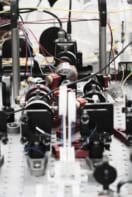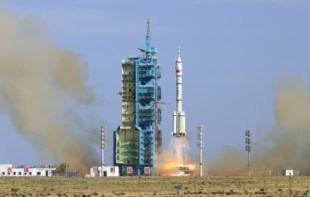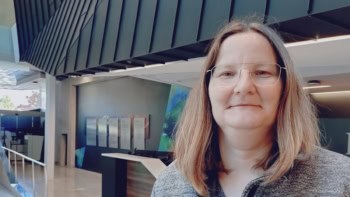Physicists in France have proposed a new scheme for using pulses of light to make an accurate measurement of the distance between two objects in space. The technique, which has not yet been confirmed experimentally, could allow measurements to be made at the highest possible accuracy allowed by quantum mechanics. The method could someday be used to boost the performance of some space-borne instruments, say the researchers.
The standard quantum limit (SQL) in space-time positioning exists because of the quantum nature of light, which introduces fluctuations in measurements that rely on the exchange of light pulses. The SQL could never be reached for light pulses sent through Earth’s atmosphere, which introduces too much noise in the signal, but it could be relevant for some space applications where the distance between spacecrafts must be accurately controlled.
The Einstein protocol
Scientists routinely measure the position in space between two objects A and B using the “Einstein protocol”, which involves repeatedly exchanging light pulses between the objects. Object A sends a light pulse at time t1 (measured with a clock in A), which is then received at time t2 in B (measured with a clock in B). The signal is then immediately sent back to A with a return time t3 (measured with A’s clock).
What is new in our scheme is that we extract the timing signal with the best accuracy ever Brahim Lamine, Pierre and Marie Curie University
The distance between A and B can be calculated using the equation D=c(t3–t1)/2, where c is the speed of light. This is the Einstein definition of distance and is also known as a two-way ranging signal. The offset, Δt, between the times given by the two clocks is Δt=t2–( t3+t1)/2, which is called the Einstein synchronization protocol, or two-way clock synchronization.
This method involves performing pulse timing to measure the three time values. Although highly accurate, a fundamental limitation arises from the quantum nature of light, which introduces fluctuations in these timing measurements, leading to SQL. Light always contains quantum fluctuations — which come from the fact that photons are not regularly spaced in the light beam.
Reaching the yoctosecond range
Brahim Lamine and colleagues of the Pierre and Marie Curie University in Paris have shown that it is possible to reduce the noise in the observable signal being measured, so reducing the SQL (Phys. Rev. Lett. 101 123601). The researchers say they can do this by using a technique that combines “homodyne detection” and “mode-locked” femtosecond lasers. This leads to a new SQL in time transfer between two clocks, potentially reaching the yoctosecond range (10–21 s to 10–24 s). The secret behind the scheme lies in the use of “squeezed” light beams from the femtosecond lasers that redistribute the noise, so making timing measurements less noisy overall.
Mode-locked femtosecond lasers are simply a succession of pulses where the relative phase between the “carrier” — the oscillation of the electric field inside the light pulse envelope — and envelope is well defined. For example, it can have a constant value, or can be equal to zero. The coherent light pulses from the lasers carry time information in their oscillations, or wave phase, and on their envelope.
Lamine and colleagues aim to extract information from both phase and envelope using homodyne detection (the difference between two interference signals obtained from the incoming pulses and some reference pulses). Any change in distance between objects A and B leads to a modification of the interference signal. “What is new in our scheme is that we extract the timing signal with the best accuracy ever — that is, we extract the signal from both envelope and phase inside the envelope,” explained Lamine.
“Although our protocol is not directly useful for GPS — because propagation of the pulses in the atmosphere causes too much noise in the signal — it could be used for improving the positioning between satellites for future space applications,” he told physicsworld.com. “Here, external perturbations are small and high accuracy can be achieved.”
Good examples are LISA (Laser Interferometer Space Antenna), which will detect gravitational waves, post-GRACE (Gravity Recovery and Climate Experiment) missions, which will determine Earth’s gravity field and DARWIN, a flotilla of spacecraft to detect Earth-like exoplanets.



